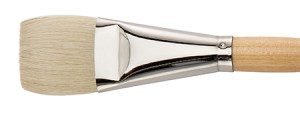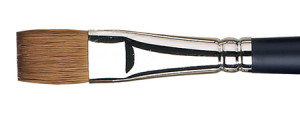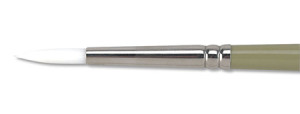All You've Ever Wanted to Know About Artist Brushes and Then Some — Part 1

An artist's unmarried most of import tool in oil painting is their fine art brushes. It's the principal piece of equipment used to apply paint to canvas.
Artist brushes come in a wide variety of types, sizes, and shapes. Knowing all you can near the different kinds of artist paintbrushes available and how they are used will allow yous to cull the right one for each stage of your canvas painting.
Beefcake of Creative person Brushes
A paintbrush's beefcake is fabricated upwards of 3 basic parts. These are the head, the ferrule, and the handle. It isn't necessary to know this to create a cute painting. However, by knowing the different parts, you will exist familiar with various fine art terms.

-
- Head — The hairs or beard of the castor. The strands are made from either natural or synthetic fibers. This is what an artist uses to apply and push button paint around on the sail. The head has 3 parts too. The very tip of the head is called the toe. The fattest role is chosen the abdomen, and the point where the head meets the ferrule is called the heel.
- Ferrule — The metal cylinder that attaches the head to the handle and helps concur the hairs in shape. High-quality ferrules won't rust or come loose.
- Handle — The long stem of the brush that is held when in utilize. It is normally made of woods or plastic. The length of the handle can vary. A quality brush will remainder on your finger regardless of the size.
For additional information virtually the parts of a brush, encounter the article titled Anatomy of The Artist Paint Brush.
Hair Types Used in Artist Brushes
Artist brushes come in a multifariousness of types. Knowing what those types are is benign in knowing which brush to utilise to accomplish the effect you desire in your paintings. There are two primary types of hairs in paintbrushes – bristle and sable. A different kind of castor hair is synthetic.


Sable brushes are neat for blending, glazing, and making soft, less-divers brushstrokes. When compared to a bristle brush, you volition discover their hairs are softer and much more fragile. In addition, sable brushes will not leave tiny grooves in your paint. They are capable of smoothing out the brushstrokes left by other types of brushes and volition give your painting a smoother, softer look when you don't desire your brush strokes to bear witness. Artists prefer using them for more frail applications of paint and effectively detailed work. Sable brushes are the near expensive and will require more than care than all of your fine art brushes.

Synthetic brushes range from soft to stiff hairs. They can exist tapered, tipped, flagged, abraded, or etched to increase their paint carrying ability. They are more than affordable than natural brushes fabricated from animal hair; all the same, they are non quite every bit good.
The strands of synthetic brushes tend to stick together when they go moisture, are prone to wear out faster, and are harder to work with. The individual strands often spread out in all directions, fall out, and may become a permanent part of your oil painting. However, in that location are some advantages to synthetic brushes. They are less decumbent to beingness damaged by solvents, insects, or caustic paints. They are besides easier to clean than natural pilus brushes because the filaments won't trap paint like natural hairs will.
For additional data about the different brush types, see the article titled Types of Bristles for Oil Painting Brushes.
Continued in Part ii.
Additional Reading
All You've Always Wanted to Know Most Artist Brushes then Some — Part two
All You've Ever Wanted to Know Almost Artist Brushes and And so Some — Part 3
Have a question?
If you accept a question nearly this painting, delight contact u.s., and nosotros'll be happy to respond any of your questions.
Thanks for reading this!
Feel free to share this with your friends.
Savor this page? Please share it. Thanks!
Source: http://teresabernardart.com/about-artist-brushes/
0 Response to "All You've Ever Wanted to Know About Artist Brushes and Then Some — Part 1"
Post a Comment